Varsha won the second 🥈 prize for beat oral communication! Well done Varsha well deserved !
16.05.2025 15:26 — 👍 0 🔁 0 💬 0 📌 0

And @salisburyfish.bsky.social wins first prize for the beat on oral communication! 🎉🎉
Well done Sarah !
#ISGAXV
16.05.2025 15:25 — 👍 3 🔁 1 💬 0 📌 0

It's not a difference in cell types but how the fish use their cells (encapsulation of the parasite for coho for example) or how the parasite immunomodulatea the fish (as in Atlantic salmons)
Sarah is leaving the Roslin and starting her group in @exeter.ac.uk, she will be missed !
15.05.2025 09:09 — 👍 2 🔁 1 💬 0 📌 0
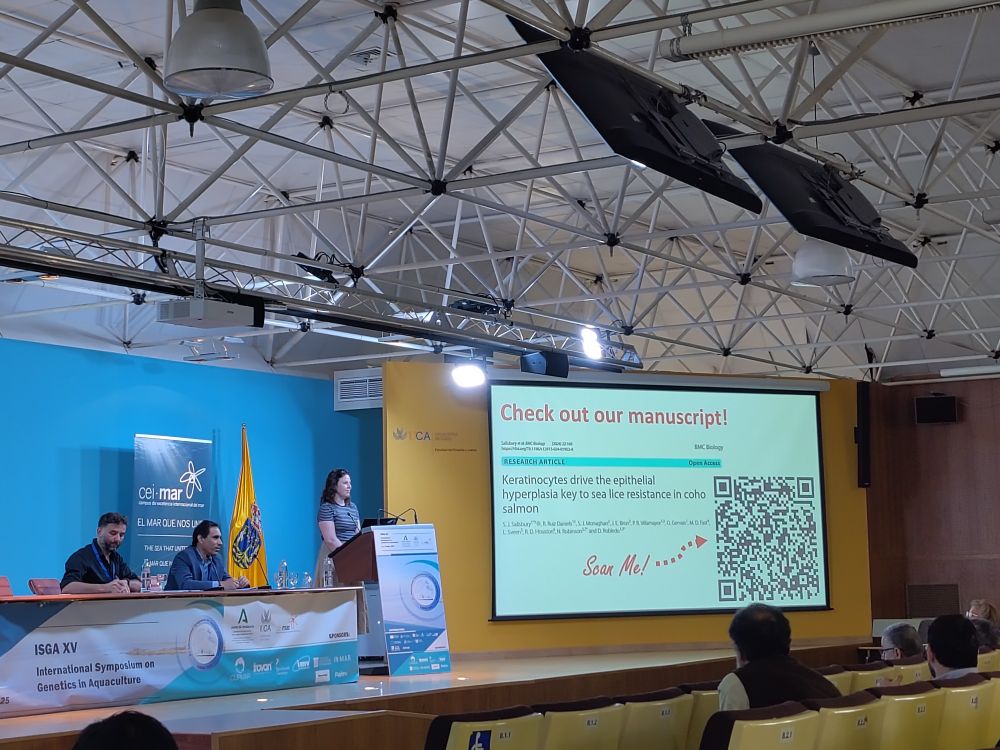
As always the presentation by @salisburyfish.bsky.social was great! Using Single nuclei RNAseq data she identified genes that seems to explain why some salmonids (such as coho or pink) are resistant to sealice when others (Atlantic and chum) are susceptible
15.05.2025 09:09 — 👍 3 🔁 1 💬 1 📌 0
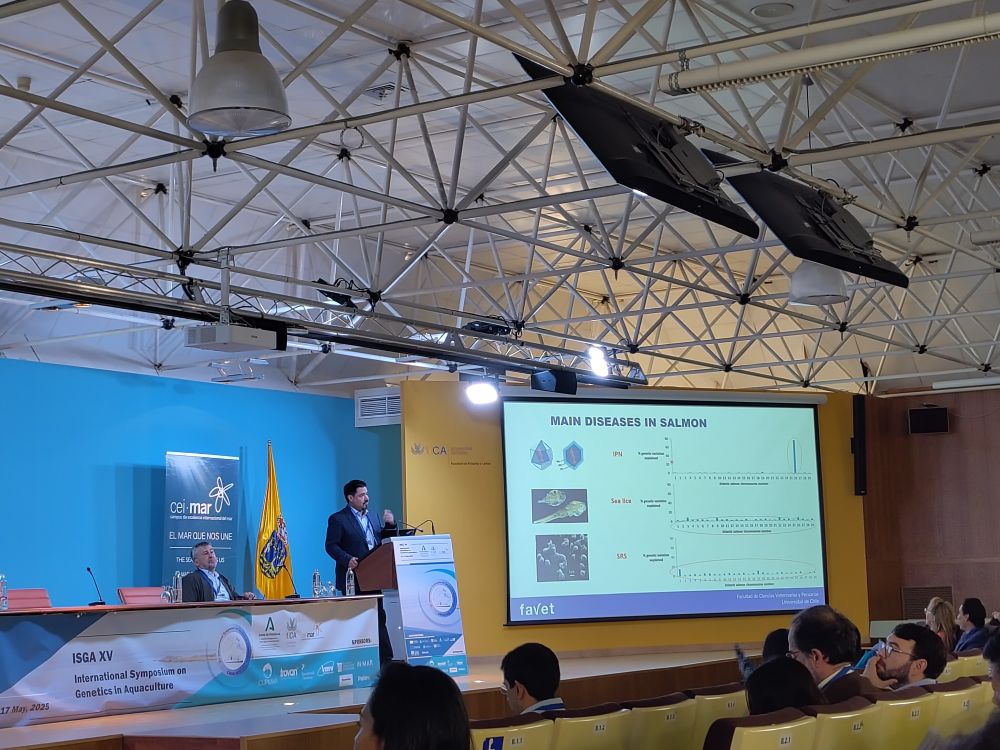
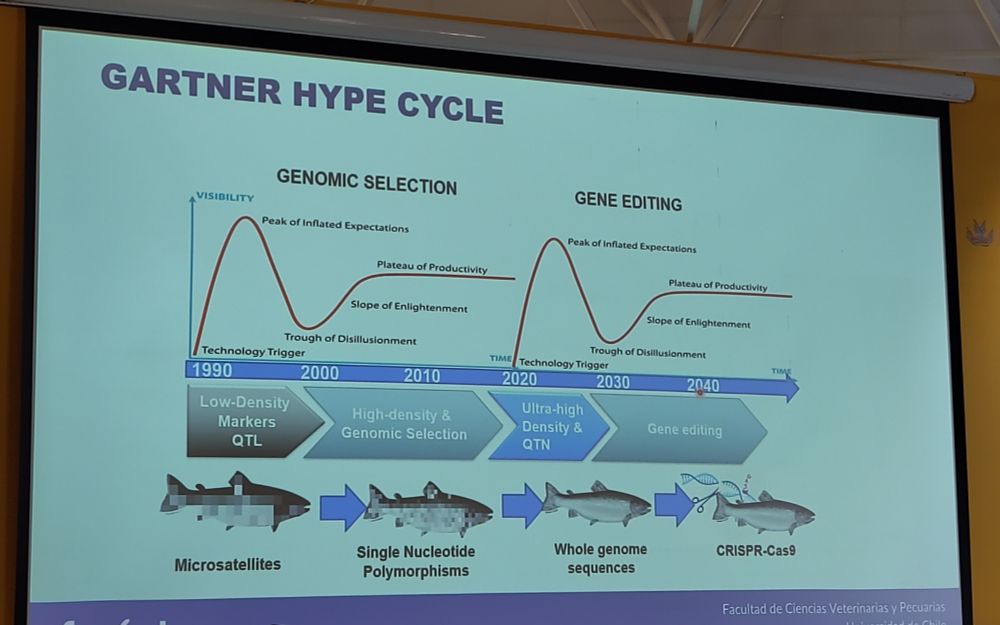
José's group has been instrumental in developing genomic selection and investigating generic architecture of complex disease resistance traits in salmonids in Chile with also a worldwide impact. The present resolve around high density, wgs data, will the future be gene editing? 🧬✂️
🧪🧬🖥️
15.05.2025 08:31 — 👍 3 🔁 1 💬 0 📌 0
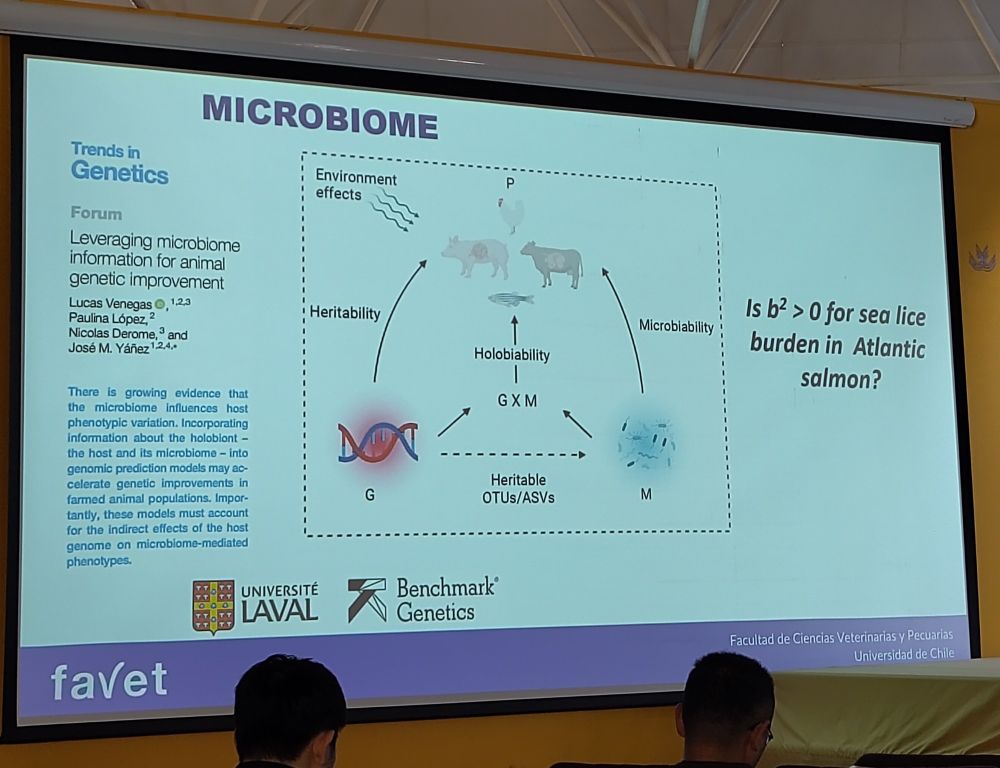
There will be more, including a talk by @lucavegu.bsky.social later today on host génome and skin microbiome information for sea lice burden in A. salmon!
There are a few posters as well to look at during the breaks and poster session 👀
15.05.2025 08:31 — 👍 4 🔁 1 💬 1 📌 0
The Chilean delegation came in number, we had a couple of talks already on rainbow trout: on IPNv resistance and impact of l vaccination of Genomic predictions, characterisation of impact of transposable elements in response to SRS 🌈🐟
15.05.2025 08:31 — 👍 1 🔁 1 💬 1 📌 0
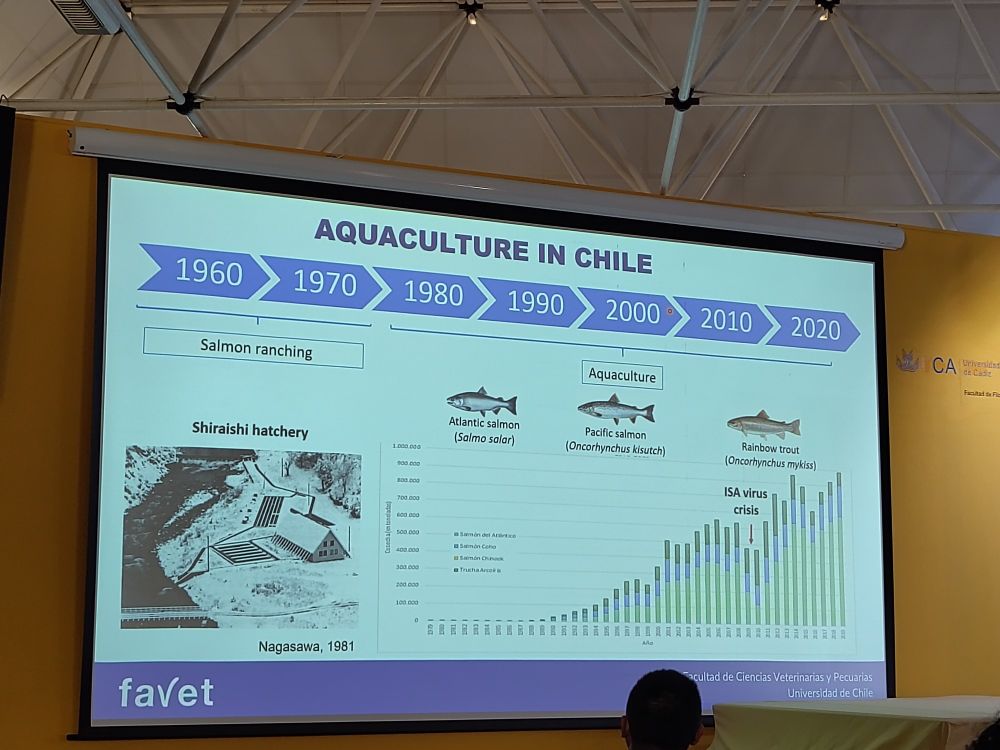
Day 4 at #ISGAXV starting with José M. Yáñez (Universidad de Chile) presenting the achievements and future perspectives of genetic improvement in salmonids (coho and Atlantic salmons and rainbow trout) in Chile.
From SNP array development to implementation of genomic selection 🧬🖥️🐟
15.05.2025 08:31 — 👍 4 🔁 1 💬 1 📌 0
@romainmorvezen.bsky.social is now looking for a postdoc to analyse new dataset of phenotypes and genotypes for field mortality resistance so if you want to join the SYSAAF team in Rennes reach out to him (I've collaborated with them during my PhD and it's a great group!)
🧬🖥️
14.05.2025 07:48 — 👍 3 🔁 1 💬 1 📌 0
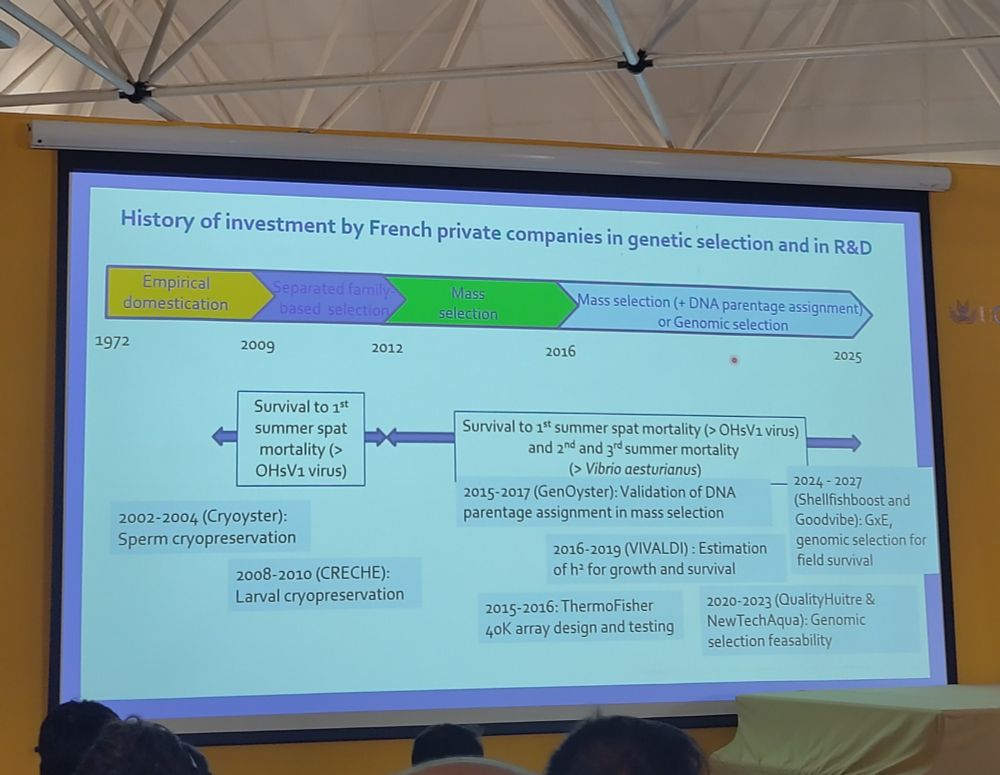
In France, mass selection is combined with parentage assignment to maintain genetic diversity since 2012 and since 2019 genomic selection is also used to improve oyster resistance to diseases, with great success so far !
14.05.2025 07:48 — 👍 1 🔁 1 💬 1 📌 0
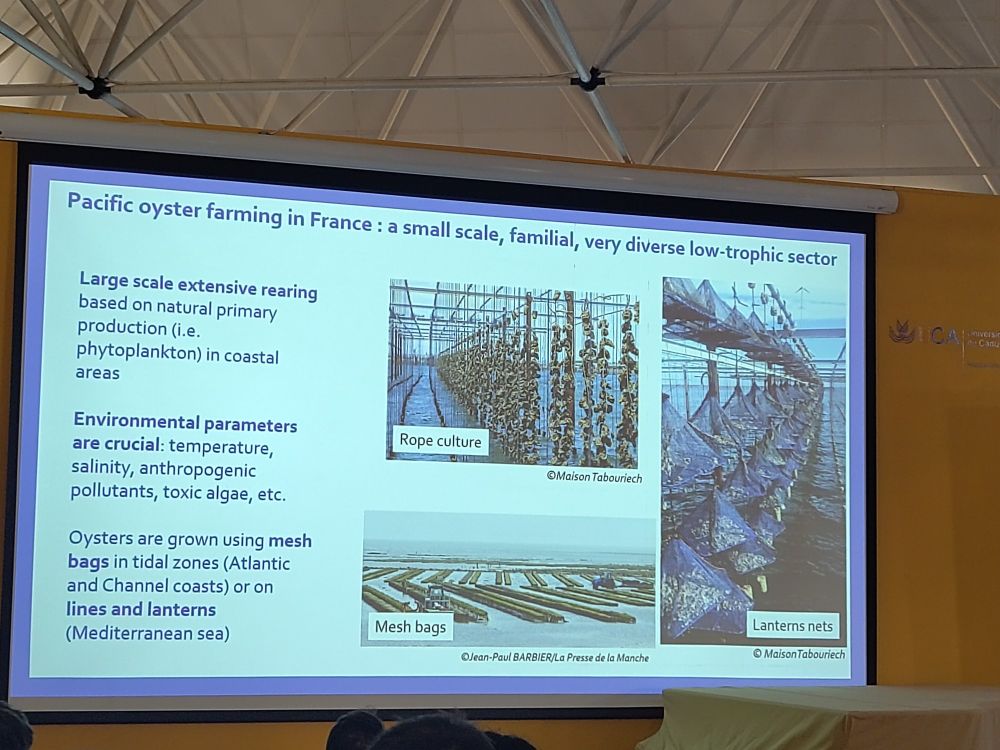
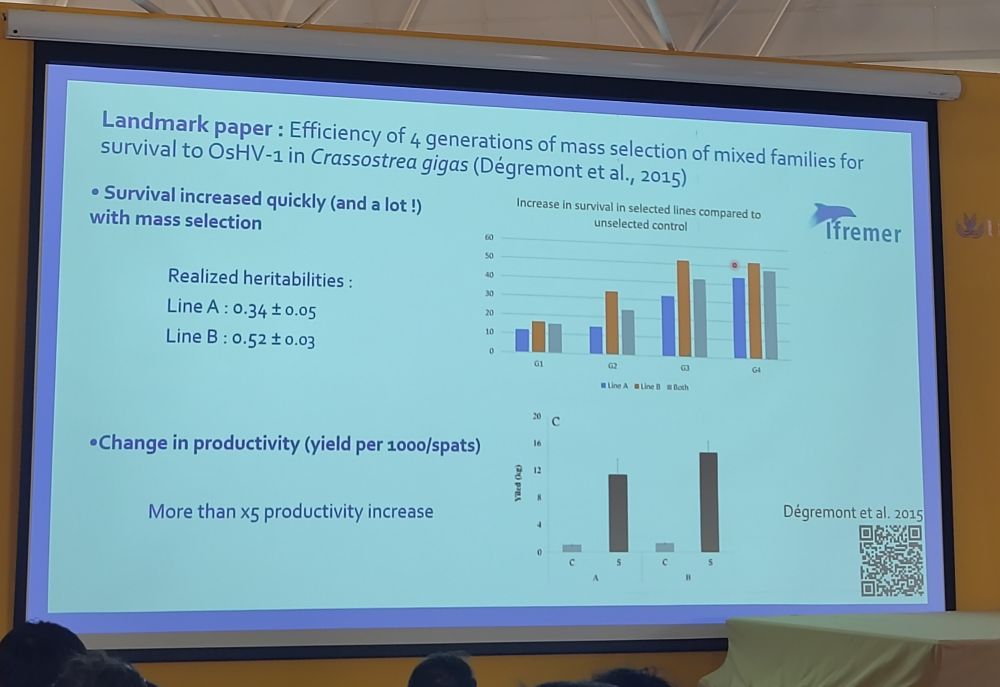
In France oysters are pretty important, and hatchery spat (baby 🦪) represent 30/40% of total spat but more than 50% of final produce because selected oysters perform better than wild one, especially when facing pathogens
14.05.2025 07:48 — 👍 1 🔁 1 💬 1 📌 0
Day 3 of #ISGA. I did not report in all the talks of yesterday. They were all super good I'll try to summarise a few here today but since everything is highly relevant I'm struggling to multitask...
Today's plenary was an overview of oyster production and selection in France by Romain Morvezen
14.05.2025 07:48 — 👍 1 🔁 1 💬 1 📌 0
Using cohabitation Batya tried to answer if those fishes can be infected by the virus (not really) if they can transmit the disease and infect common carp (no) and with injection she looked at resistance (do they die? No)
A super clever approach! I can't wait to read the publication! 🧬🐟
13.05.2025 10:07 — 👍 1 🔁 1 💬 0 📌 0
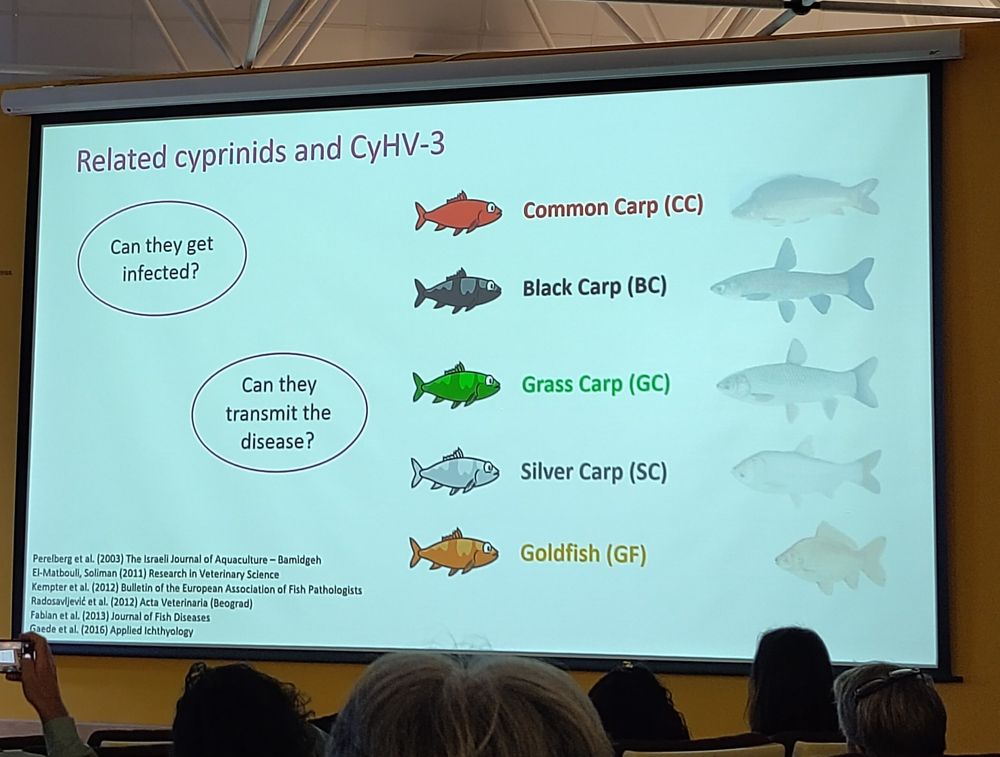
Really cool presentation at #ISGAXV from Batya Dorfman on disentangling the component of disease resistance (susceptibility transmissibility and survival) of Cyprind fish species to CyHV-3. They looks at infection response in multiple challenge models with 5 carps species
13.05.2025 10:07 — 👍 2 🔁 1 💬 1 📌 0
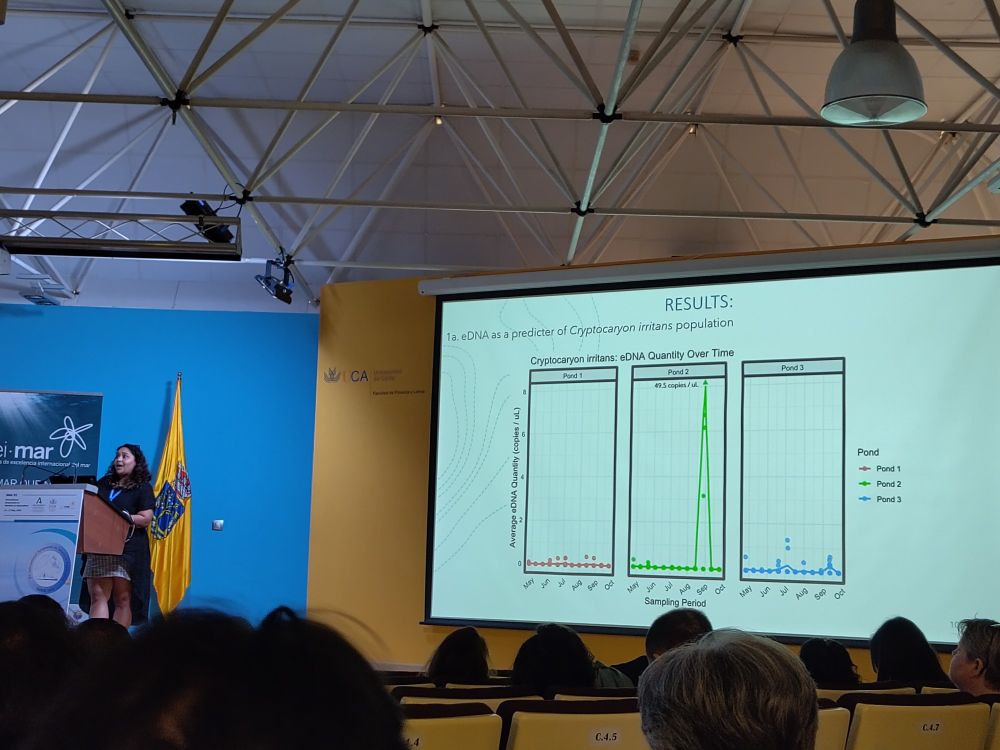
Omics can also be used to detect early pathogen outbreaks in pounds for barramundi, as shown by Varsha Balu (James Cook Uni, Australia). Using eDNA from water sampling (non invasive) she was able to detect the presence of two pathogens in pounds, that could be associated with changes in salinity.
13.05.2025 08:40 — 👍 3 🔁 1 💬 1 📌 0
The Genetics and genomic of diseases session is going strong at #ISGAXV 🦐🐟🦪🧬🖥️
We heard from Duwage C.G. Rodrigo (Jeju Uni, Korea) about resistance to M avidus in olive flounders. Polygenic + heritable = genomic selection to improve resistance in the population ✅
13.05.2025 08:40 — 👍 3 🔁 1 💬 1 📌 0
We also need to consider social acceptance of gene editing among consumers.
A lot to think about for a technology that will be part of the future of selective breeding for some aquaculture species and companies
13.05.2025 08:27 — 👍 1 🔁 1 💬 0 📌 0
But designing a breeding programme to incorporate edited genotypes and to maintain it requires some thinking: we need to keep a high effective population number, keep diversity, make sure the edited fish are competitive VS selectively selected fish
13.05.2025 08:27 — 👍 1 🔁 1 💬 1 📌 0
Day 2 of #ISGAXV, in the plenary Anna Sonesson from Nofima (Norway) gave us her insights on how to design breeding programmes to integrate gene editing. GE is a very promising tool to increase disease resistance when the causal gene is known, to quickly fix a favourable allele in the population
🧬🐟
13.05.2025 08:27 — 👍 2 🔁 1 💬 1 📌 0
At #ISGAXV, Florence Phocas from @umr-gabi.bsky.social just presented their latest results (available in BioRxiv) and identified 63 SNPs explaining up to 74% of the genetic variance after immersion challenges in commercial rainbow trout.
A work done with colleagues from #SYSAAF
12.05.2025 16:28 — 👍 1 🔁 1 💬 0 📌 0
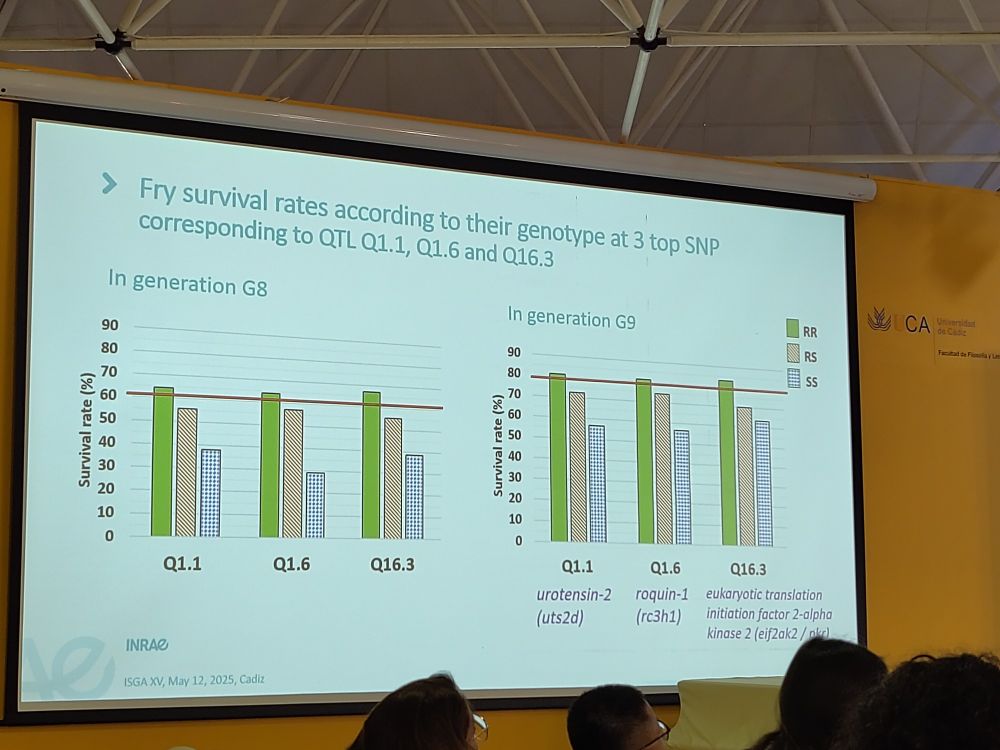
Have you heard about IPNv and salmonids? Maybe you know that there is a major QTL that was identified in A. Salmon in 2008/2009... Well this time there is major QTLs identified in rainbow trout for the same disease !
www.biorxiv.org/content/10.1...
12.05.2025 16:28 — 👍 1 🔁 1 💬 1 📌 0
Followed by another 🦪 presentation by Hooi Ling Khaw, looking at genetic variance of uniformity of Pacific oyster shells.
12.05.2025 15:57 — 👍 1 🔁 1 💬 0 📌 0
Another 🦐 talk with Marina Martinez Soler estimating genetic parameter of resistance to hepatopancreas necrosis after an immersion or a feed induced challenge. Survival had a medium h2 with positive correlation with growth (high in immersion, low in feed induced mortality)
12.05.2025 15:57 — 👍 1 🔁 1 💬 1 📌 0
Still at #ISGAXV and attending the last session of the day.🧬🖥️🐟🦪🦐
Earlier there was a presentation by Pierrick Haffray (SYSAAF) on accounting for molt stages in genetic evaluation of 🔵🦐. Showing that time to molt was heritable but molt stages wasn't in their dataset (late measurement)
12.05.2025 15:57 — 👍 1 🔁 1 💬 1 📌 0
So far it's been really good, high quality talks (and great weather and food which is also important to fuel the brain)
12.05.2025 15:34 — 👍 1 🔁 0 💬 0 📌 0
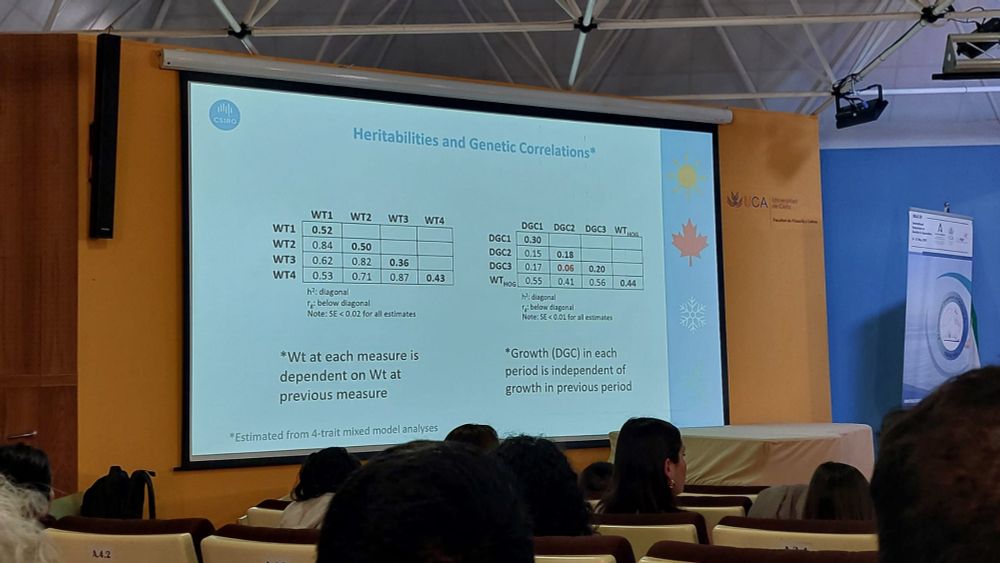
An interesting study by Brad Evans from CSIRO on seasonal growth of A. salmon in Tasmania (where the water is warmer than in Scotland). They showed differences in summer growth between families. Low genetic correlation estimates between growth measured at different time
🌨️🌧️☀️🍂
12.05.2025 13:52 — 👍 2 🔁 1 💬 1 📌 0
Simon Pouil from @umr-gabi.bsky.social looked (and found) selection signature in two divergent lines of rainbow trout selected for fat content l, identifying regions on Chr 7 linked with fat deposition but also energy metabolism and stress response 🐟🌈 🧬
12.05.2025 13:20 — 👍 1 🔁 1 💬 1 📌 0
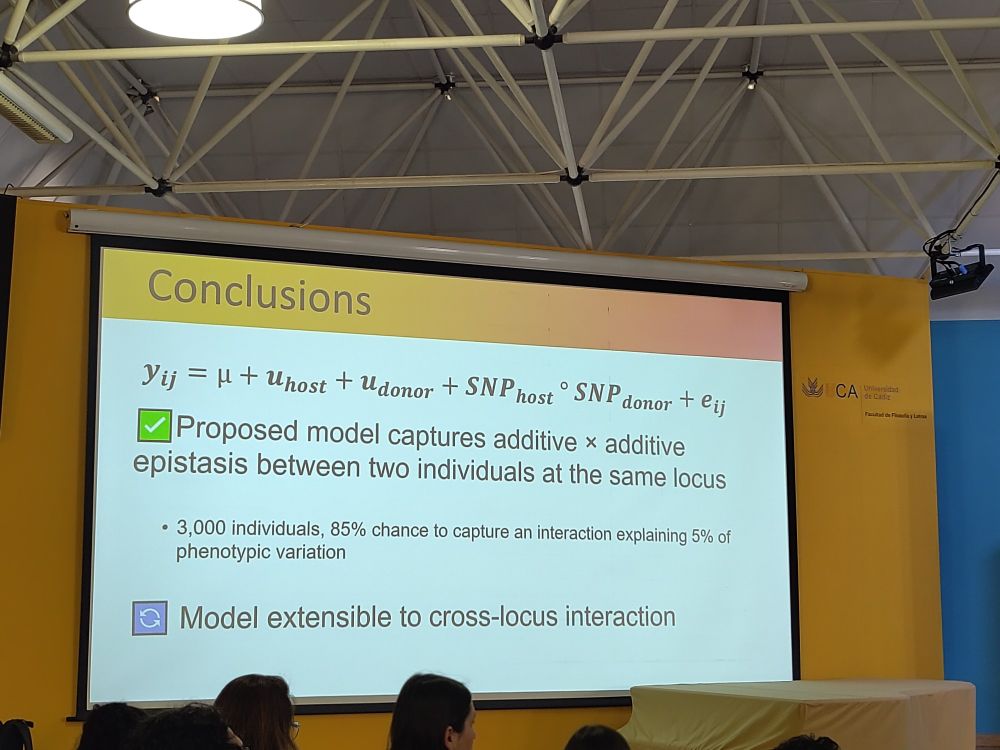
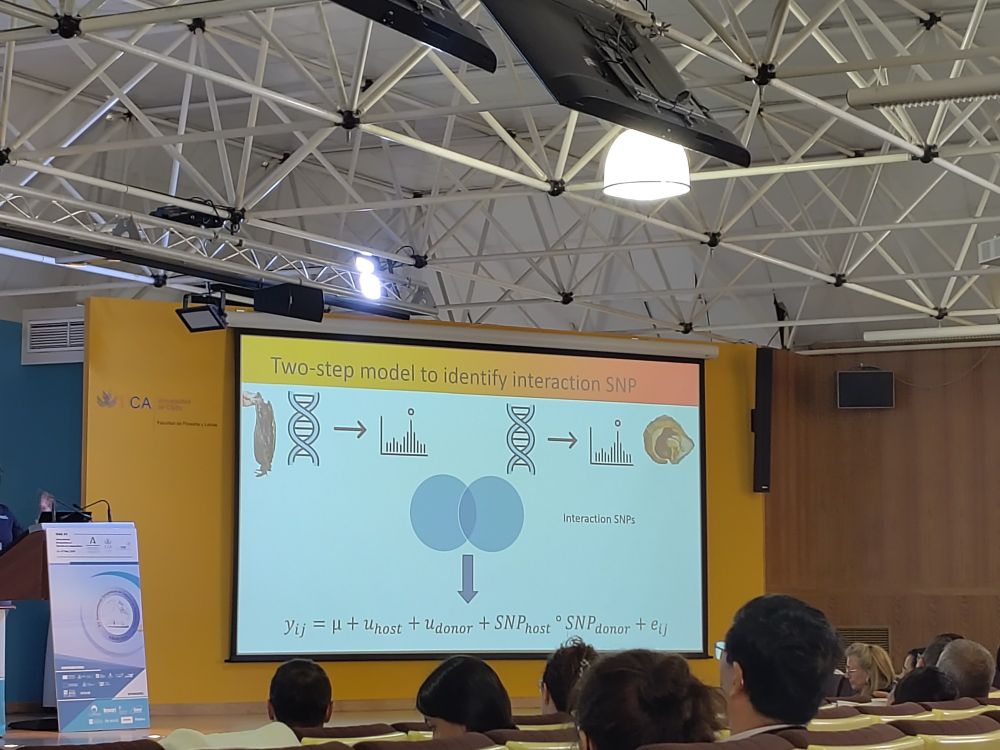
Back from lunch at #ISGAXV and it's time for quantitative genetics and breeding 🧬🖥️ and we started with Cécile Massault presenting her model that captures the additive genetic host-donor interaction in pearl oyster, looking at incorporating it in breeding programme for pearl size 🦪
12.05.2025 13:20 — 👍 2 🔁 1 💬 1 📌 0
And the final talk of this morning #ISGAXV is on developing line breeding in tilapia (the aquatic chicken) to fit farmers demand for fish adapted to their market as "one size doesn't not fit all" as Raseh Joshi from GenoMar presented 🧬🖥️🐟
And now, we break for lunch !
12.05.2025 11:42 — 👍 1 🔁 1 💬 0 📌 0
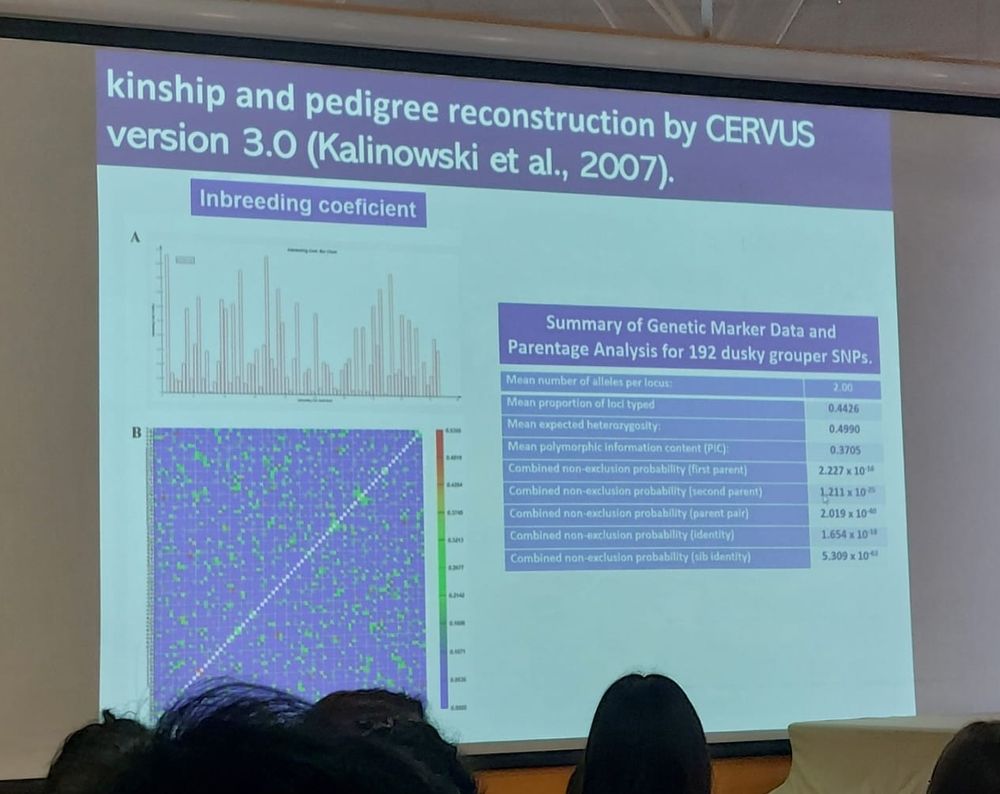
Why is aquaculture so interesting (in my opinion)? because of the diversity of environment and species that are farmed. Alexandre W. Silva Hilsdorf presented the beginning of farming and selecting Dusky grouper un Brasil. Using optimized LD SNP panel for accurate parentage assignment
12.05.2025 11:39 — 👍 2 🔁 1 💬 1 📌 0
Freshwater Ecologist at Michigan State University. Director of @msue-lakes-streams.bsky.social. Invasive species, science communication, public engagement. Hiker, kayaker, reader, listener.
Postdoctoral Researcher in @cure4aqua.bsky.social
Swansea University 🏴🇬🇧 | PhD in Biosciences Nord University 🇳🇴 | Working on Epigenetics & Microbiome
The union for academic and academic-related staff at the University of Edinburgh
UK trade union for academics, lecturers, trainers, researchers and professional services staff in further education, higher education, prison education, and adult and community education.
A platform for life sciences. Publications, research protocols, news, events, jobs and more. Sign up at https://www.lifescience.net.
Career-shifter studying sustainable agriculture and food systems. 🌱
🦪Coastal scientist, earth-enthusiast, and occasional data wrangler
💡 Passionate about ecological restoration, sustainability, and being outside
📊 Turning complex data into actionable insights
👩👧 Mom balancing science, family, and growth.
Master’s student at University of Arizona | researching a native SW desert fish: Sonora sucker | she/her | #TeamFish 🐟 | #BiinSci 🏳️🌈 | Neurodivergent 🧠
Research Culture, Leadership, FLFs .... and some knitting, swearing and occasional cancer references.
SULSA is an alliance of twelve Scottish Universities and one Research Institute that aims to advance Scotland’s research and innovation in the life sciences through strategic collaboration across institutions, disciplines and sectors
Where early career researchers speak.
Information for postdocs and early career researchers in the College of Medicine and Veterinary Medicine at the University of Edinburgh
Genetics and Genomics, Computational Biology
Aquaculture scientist in genetics and genomics.
Love fish and other animals.
MS student in the Moran Lab at Texas A&M University
Freshwater fish behavior, ecology, and conservation
#Teamfish
The goal of the Canadian BioGenome Project is to produce high-quality reference genomes 🧬 for all Canadian species 🌎
Sequencing Canada's Biodiversity 🌿🦋🐍🧬🐢🦌🐸🌳🐿🐙🦈🦦
Learn more: https://linktr.ee/canadianbiogenome
Offer access to research infrastructures to advance research in aquaculture, fisheries, ecological restoration and the blue economy.
Professor of Genetics & Reproduction, University of East Anglia
Founder and Scientific Director, Virilitas Labs
















